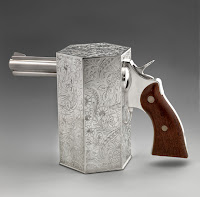Recently, Hyperallergic (an art website) published an article,
An Art Museum Designed for Taking Selfies, about the Art in Island Museum in Manila. The gallery is set up with high-res posters of great masterworks from museums all over the world with the express purpose of taking selfies. I'm going to use Jean Francois Millet's 1857 painting, The Gleaners, to talk about the pros and cons of this experience.
 |
| Visitors at the Art in Island |
 |
| Millet, Gleaners, 1857, oil on canvas |
|
Part of the difficulty for me comes with the idea of the AUTHENTIC EXPERIENCE. If we're talking about this painting we want to acknowledge that the Selfie-Gleaners is a very different work than the Millet-Gleaners. It is larger, both in the canvas (the actual painting is 33x44") and in spatial representation where the women come forward from the canvas. The color is substantially different (based on the original, which I have seen, the green is far too vibrant both in the field and the dress, the blue cap too light/acidic). A high resolution image can never really replace the tonal and textual variants of the brush work; it is far flatter than what you see in person. And heck, Michelangelo's Pieta is a sculpture, not an artificially perspectivally rendered picture.
But am I being fair to the Selfie-Gleaners when I have to admit that relatively few people see the Millet-Gleaners in person at the Musee d'Orsay in Paris? Admittedly, the Musee sees about 3 million viewers annually (based on 2009 figures) but that seems like a drop in the bucket when you consider the internet exposure. There isn't necessarily an AUTHENTIC viewing experience going on for most folks.
My major objection here is the subject change that the Art in Island folks have affected on the painting. Millet-Gleaners is about the societal reality of the mid-19th century which left some in such poverty that they gathered the wheat remains in the fields just to have a small amount to eat. It was back-breaking work with poor reward and subject to the field owner's directives of how clean to gather in the crop. And critics at the time felt the stress of the Socialism--Millet's painting spoke to the current social realities of the 1848 Revolution, with its labor and food riots, and harkened to the upheavals of the 1793 Revolution; Marx and Engels would publish the
Communist Manifesto in 1848. It is impossible to see this as anything other than a glorification of the value of Work, with a class emphasis on the foregrounded poor and the distant and inaccessible wealth. Unlike his contemporaries, Daumier and Courbet, who both ended up in political trouble (jail, exile) for their leanings, Millet denied the political interpretation of his work, arguing that he was painting the honesty of the human condition. It was not possible in France of the mid-19th c. to extricate the work from its Socialist reception.
The Selfie-Millet gives the women paintbrushes. It changes the narrative completely. While there is a referential element of "What Makes Art?" implicit here, it gives a false impression of the work, taking it completely out of its creative and historical contexts. It denies its history.
The Selfie-Millet also circumscribes what you experience in the art. You take your places amidst the scene. You are encouraged to catch the shoe of Fragonard's swinging woman (but from a position that is not that in the painting--of the lover looking up her skirts while her husband unknowingly pulls her on the swing). Napoleon crowns you, not Empress Josephine. But you aren't allowed to BE the woman on the swing or Napoleon. It is NOT a neutral experience.
To some extent, that's what a selfie is about. Selfies put the individual into the context of the work. They are documentary--a record of being at a place or event. But that documentation is fundamentally present centered and a historical--it
pulls the work of art forward into the moment of time belonging to the viewer. The museum experience--with its neutral walls and quiet atmosphere and extensive wall-text or audio tour--is about putting the viewer into the history of the art work (or at least a neutral space out of time).
If the viewer thinks they have gone to an art museum, then the Art in Island space is bad. It is not a museum. It is not even a real experience of the artwork. But it certainly exists in the context of novelty entertainment--cardboard beach cutouts of musclemen and bikini girls, rodeo cowboys, families in WWI airplanes (all photos in this
book before 1930 so you have a sense of this phenomenon). To that extent, perhaps it's good that the Selfie-Millet is SO out of context--you cannot mistake it for the real work or the real experience. I'd clearly prefer it if all of the works were significantly different from their originals.
Perhaps the Art in Island experience makes it sufficiently fun to interact with art that a viewer would be more likely to go to a real museum and see the art. I don't buy it. To be successful as entertainment, Art in Island must crop paintings, change their size, rearrange their space so as to make the viewer to interact with them. The Art in Island experience is about shaping your self with art as a backdrop. An art museum seems sterile and flat if it it is specifically set up to NOT direct your experience in the most individualistic/self-centered way. Maybe this is the distinction folks made for years with television--that it was the dumbing-down, passive experience of theater or live story-telling. We could argue whether that is true (now or ever) for television, but I do think this is making the experience of artworks EASIER, less complicated, more accessible for the viewer.
If human beings aren't always easy animals, I see no reason why we should expect our experience of the culture we make to be easy.






